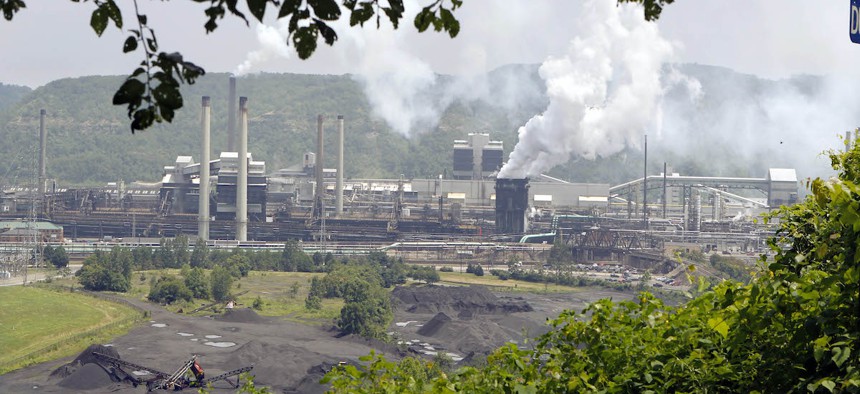After Years of Pollution, One County Meets Air Quality Standards for the First Time Ever

The United States Steel Corp.'s Clairton Coke Works is seen from the hill above it in Clairton, Pa., Wednesday, July 14, 2010. Associated Press
Allegheny County, Pennsylvania, is in compliance with federal air quality standards for the first time in its history.
At the end of January, officials in Allegheny County, Pennsylvania celebrated a long-awaited milestone: for the first time in history, all eight of the county’s air quality monitors were in compliance with federal standards.
The county, home to Pittsburgh, was once a major hub for steel-making and other heavy industry and had long endured a reputation for poor air quality—including, in past decades, monikers like “the smoky city” and “hell with the lid off,” said County Executive Rich Fitzgerald. But levels of pollutants have improved over time, and as of Jan. 28, the county meets federal benchmarks for carbon monoxide, nitrogen oxide, ozone and particulate matter.
“We’ve been getting better and better every year,” Fitzgerald said. “It’s been a gradual but steady improvement that’s continued to occur. It wasn’t just like last year, we woke up and decided to do it—it’s been a decade, probably longer than that, that we’ve continued to make improvements.”
There are eight air-quality monitors spread throughout the county, seven of which have been in compliance with federal standards for years. The eighth, located across from U.S. Steel’s Clairton Coke Works coal-processing plant, was the problem child. County officials approached the issue through a mix of enforcement actions, including more than $1 million in fines for air pollution and permit violations last year.
That, coupled with mandated improvements at the plant, helped reduce contaminants enough for the monitor to comply with federal air quality standards, Fitzgerald said.
“The Allegheny County Health Department serves as the enforcement arm for the Environmental Protection Agency and for our Department of Environmental Protection,” he said. “The health department started taking more stringent actions—legal actions, fines, all of those kinds of things, and the industry also made some improvements to lessen the pollutants that were going out through the process.”
Particulate matter (smoke and soot) readings from the monitor for 2020 show an annual average of 9.8 micrograms per cubic meter, well under the federal standard of 12 micrograms per cubic meter and also just lower than the World Health Organization’s more-stringent standard of 10 micrograms per cubic meter. (Those readings, like all of the county's data, are preliminary until certified by the EPA, a somewhat lengthy process that Fitzgerald said he’s confident will go smoothly.)
The county’s success comes at the end of a year where emissions in general plummeted, thanks to widespread Covid-19 lockdowns that kept millions of people at home and out of their cars. Worldwide, emissions decreased by more than 6%; in the United States, they declined by 13%, according to data from the Carbon Monitor project.
Environmental groups have noted the timing, saying that the county’s data was likely produced while industrial facilities were operating at less than full capacity. The Breathe Project, a collaborative of several dozen environmental groups, said that the Clairton plant “hot idled” a portion of its facility in November 2019 and that a large-capacity blast furnace at another plant was shut down for three months in 2020.
“While news of reductions in air pollution in our county is always welcomed, the Breathe Project wants to make it clear that any victory celebrations would be premature and potentially misleading because of the particular circumstances,” Matthew Mehalik, the organization’s executive director, said in a statement.
But county officials rejected those claims, noting that they were expecting to achieve compliance in 2020 well before the onset of the pandemic.
“We were on track to make it and we could see that improvement coming,” Fitzgerald said. “It was a big goal for us to reach and achieve, and we’re very proud of the fact that we’ve been able to do it.”
Kate Elizabeth Queram is a staff correspondent for Route Fifty and is based in Washington, D.C.
NEXT STORY: 100 Million Covid Shots in 100 Days Doesn’t Get Us Back to Normal





